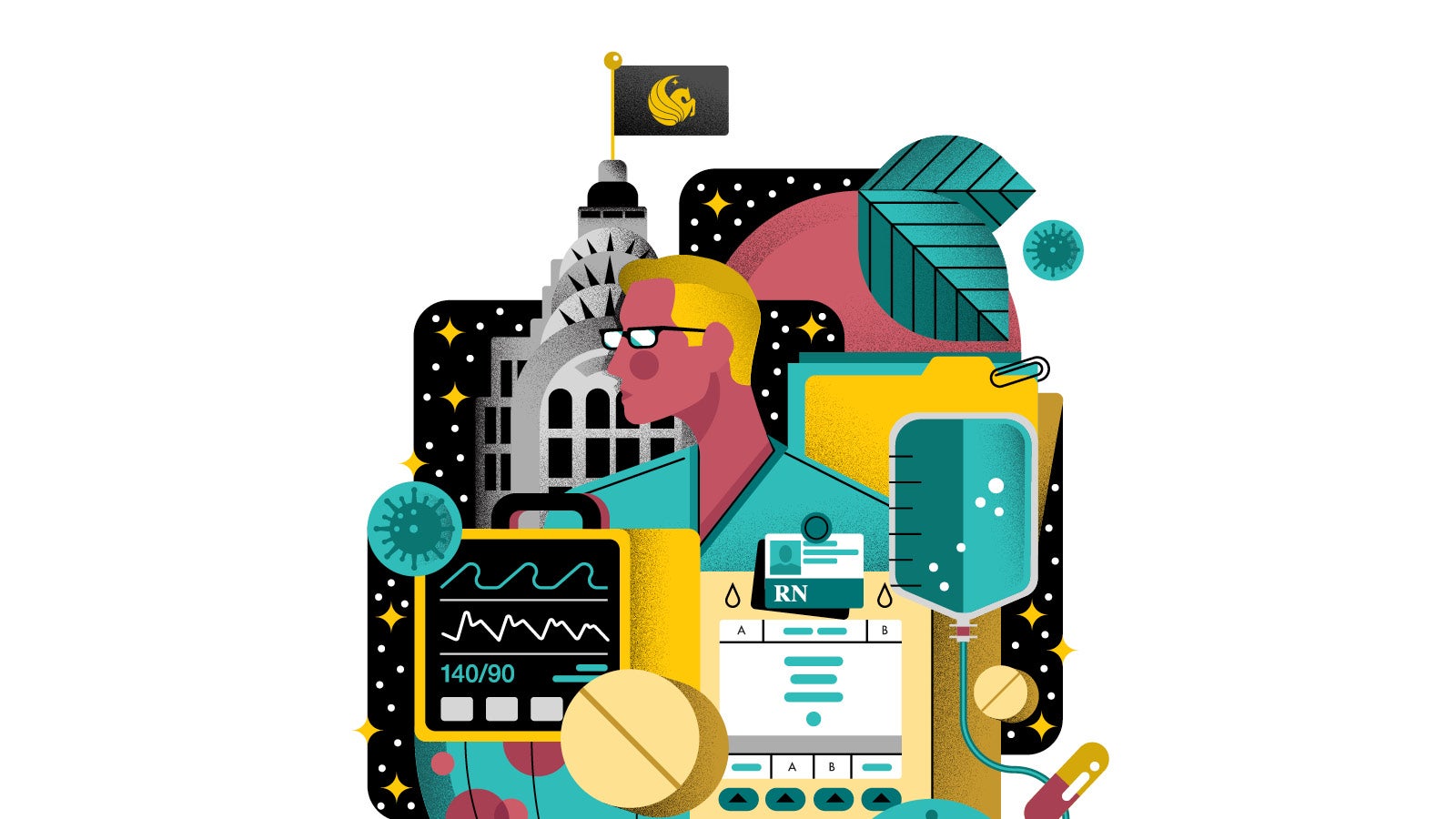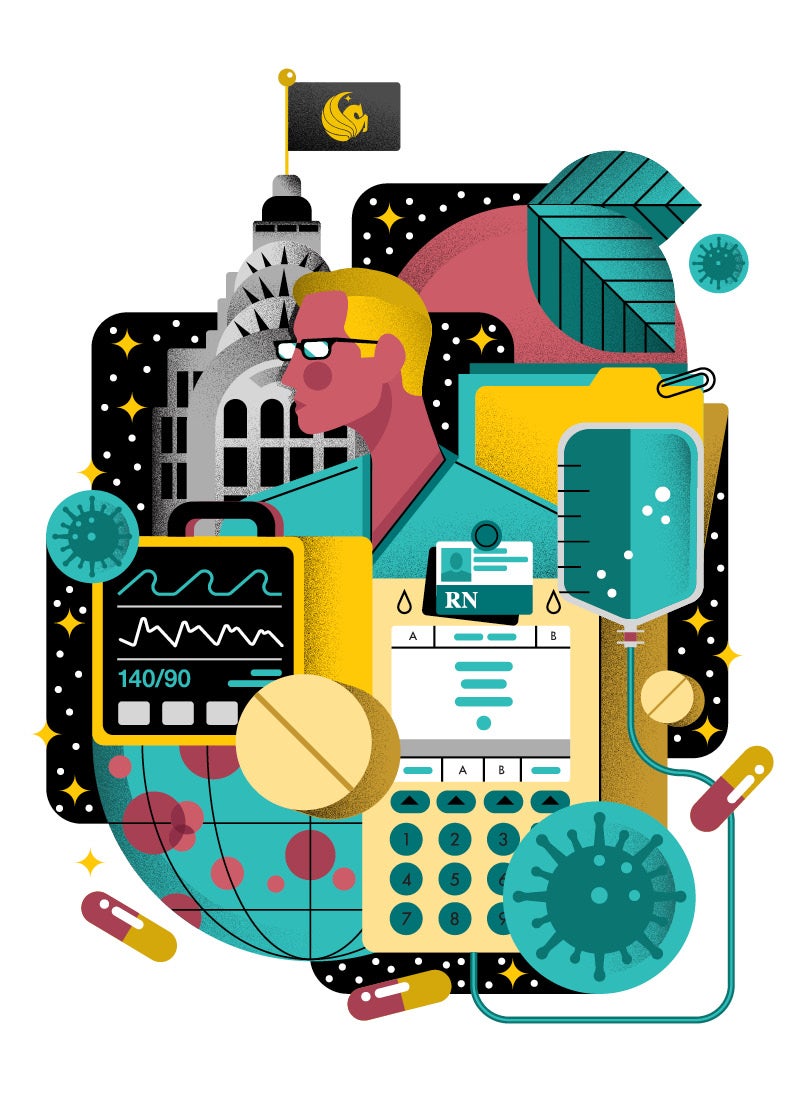
Why I Fight on the Frontline
Summer 2020 | By Stephen Brennan ’15
This past February I was celebrating a birthday with a few friends and our pack of dogs in a snow-covered cabin in the North Carolina mountains with few cares. We were all happy, healthy, employed and living in a time when the coronavirus was still a somewhat small news story in the United States.
If someone told me that fewer than two months later I would quit my job, drive from Orlando to New York, and start working as a nurse in a pandemic-ravaged state, I would have brushed it off with an eye roll and a dismissive laugh. But here I am, months later, working in the worst hit state in our country.
After graduating from UCF with my nursing degree, I was able to land my dream job at Orlando Regional Medical Center, which has Central Florida’s only Level I trauma center. During those five years, I was exposed to all types of patient care, including severe medical and traumatic cases. With each patient that came through our doors, I learned to work without fear and to be ready with little or no warning.
Little did I know that I soon would use these skills outside of the trauma room — when I felt the call to go to New York.
I resigned from my position and accepted a traveling nurse position as an intensive care unit nurse. I was experiencing every emotion from paralyzing fear to what-could-possibly-happen-next excitement, but fortunately what made this transition easier is that I didn’t do it alone. Two other nurses also decided to serve in New York. About 17 hours and nearly 1,100 miles later, we arrived ready for duty.
We walked into the hospital with no idea what to expect. Normally we are ER nurses, but we were assigned to work in an ICU because of the desperate need for capable nurses. I walked in and read my first assignment — in the basement. After a split second of fear, I pushed my mind back to my ER training: Don’t be scared, just be ready.
After going down a series of stairs and dimly lit hallways, I arrived in the basement, where a research library had been converted to an ICU to accommodate the rapidly growing intake of critical patients. This basement wasn’t the only reconfigured space. Nearly all possible areas were converted in a similar fashion to provide the best care possible.
At that instant, there are few words that could accurately describe what I felt.
In a moment when I didn’t know exactly what to do, I went through the routine of donning my personal protective equipment: gown, double gloves, mask, goggles, face shield and hair cap. This familiar uniform helped calm my thoughts as I walked through the basement doors into the ICU to begin my first shift. I had to force myself not to drop my jaw and break the seal on my treasured N95 mask.
But I had less control over my eyes. They grew bigger and bigger as I scanned the unit. I had to fight back tears as I saw firsthand the seriousness of this pandemic and the fight these patients were experiencing. There were 14 patients lined up around a temporary wall that housed medical oxygen and suction supply. Patients were positioned about 3 feet apart and connected to different ventilators, medication pumps, blood transfusion pumps, and everything else you would expect to see in a large ICU but crammed in a small area the size of a conference room. Patients I had only read about now had faces, names and families.
As I felt a tear form, my mind flashed back to a great nurse mentor of mine who chanted words of encouragement using a favorite movie reference: “Brennan, ain’t no crying in baseball!” She said this as a reminder to stay strong — for these patients and my fellow nurses. With that, I blinked my tear away and got to work.
Whether it was suctioning airways, repositioning patients in bed, frequent medication administrating and titrating, and continuous monitoring, there wasn’t a moment that went by in that first 13-hour shift when something wasn’t alarming and in need of immediate attention.
That 13-hour day became the norm, four days a week.
No two patients have the same symptoms. No two patients have the same course of treatment. Every patient responds differently as this disease progresses. Because of the inability to predict the virus, the plan of care is a reaction to what symptoms arise, which makes it a difficult battle to fight. Nevertheless, we continue to fight our best for our patients’ recovery.
Only a few months ago, I was sitting at my house with my dogs and knew what to expect each day. Today, I’m sitting in an Airbnb in Jamaica, Queens, with two friends — and I have no idea what to expect when my contract ends in June.
However, amid the uncertainty and unknown, I absolutely love what I do. And I know that I will continue to work the front line wherever I’m needed most.
Stephen Brennan ’15 spent five years working at Orlando Regional Medical Center, where he received his certification in emergency nursing as well as a national Daisy Award for extraordinary nurses.
